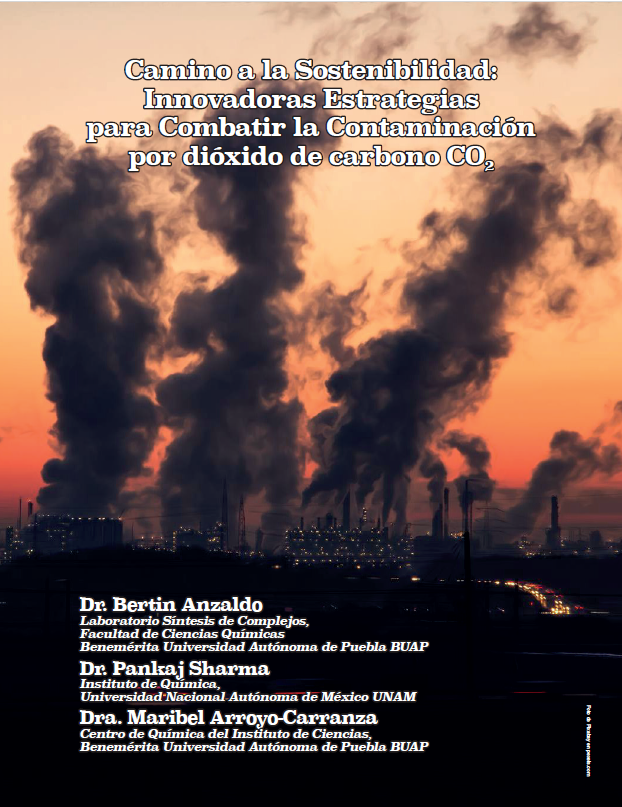Camino a la Sostenibilidad
Innovadoras Estrategias para Combatir la Contaminación por dióxido de carbono CO2
Abstract
The transformation of nontoxic carbon dioxide (CO2) into fuels and valuable chemicals has become an interesting approach to address CO2 emissions and can help in addressing climate change. A promising solution lies in using solar energy to convert CO2 into useful materials, which could pave the way for a more sustainable future. Solar energy has the potential to trigger chemical reactions that enable the production of plastics and pharmaceuticals. Researchers are working on different approaches, such as photocatalysis, photoelectrochemical conversion, and microbial photoelectrochemical conversion, to transform CO2 into valuable chemicals and fuels using solar energy. These methods can reduce the environmental impact of emissions and help address climate change while also providing opportunities for the production of useful materials.
Downloads
References
Balzani, V., Pacchioni, G., Prato, M. y colaboradores. Solar-driven chemistry: towards new catalytic solutions for a sustainable world. Rend. Fis. Acc. Lincei, 30, pp.443–452, 2019. https://doi.org/10.1007/ s12210-019-00836-2.
Bhattacharjee, S., Rahaman, M., Andrei, V. y colaboradores. Photoelectrochemical CO2-to-fuel conversion with simultaneous plastic reforming. Nat. Synth., 2, pp.182– 192 2023. https://doi.org/10.1038/s44160- 022-00196-0.
De Luna, P., Quintero-Bermudez, R., Dinh, CT. y colaboradores. Catalyst electro- redeposition controls morphology and oxidation state for selective carbon dioxide reduction. Nat Catal., 1, pp.103–110, 2018. https://doi.org/10.1038/s41929- 017-0018-9.
DiMeglio, J. L. y Joel Rosenthal. Selective Conversion of CO2 to CO with High Efficiency Using an Inexpensive Bismuth-Based Electrocatalyst. J. Am. Chem. Soc., 135[24], pp.8798-8801, 2013. https://doi. org/10.1021/ja4033549.
Gomes, C. Das N., Jacquet, O., Villiers, C., Thuéry, P., Ephritikhine, M. y Cantat, T. A Diagonal Approach to Chemical Recycling of Carbon Dioxide: Organocatalytic Transformation for the Reductive Functionalization of CO2. Angew. Chem. Int. Ed., 51, pp.187-190, 2012. https : // doi.org/ 10.1002/anie.201105516.
He, J., y Janáky, C. Recent Advances in Solar-Driven Carbon Dioxide Conversion: Expectations versus Reality. ACS Energy Letters, 5[6], pp.1996-2014, 2020. https : // doi.org/10.1021/ acsenergylett.0c00645.
Kron, K. J., Gomez, S. J., Mao, Y., Cave, R. J., y Sharada, S. M. Computational Analysis of Electron Transfer Kinetics for CO2 Reduction with Organic Photoredox Catalysts. The Journal of Physical Chemistry A, 124[26], pp.5359-5368, 2020. https : // doi.org/10.1021/acs.jpca.0c03065.
Peter, S. C. Reduction of CO2 to Chemicals and Fuels: A Solution to Global Warming and Energy Crisis. ACS Energy Letters, 3[7], pp.1557-1561, 2018. https : //doi.org/ 10.1021/ acsenergylett.8b00878.
Rashid, R. T., Chen, Y., Liu, X., Zhou, B., y colaboradores. Tunable green syngas generation from CO2 and H2O with sunlight as the only energy input. PNAS, 119[26], e2121174119, 2022. https://doi. org/10.1073/pnas.2121174119.
Viswanathan, B. Reduction of Carbon Dioxide: Photo-Catalytic Route to Solar Fuels. Lee, J. (eds) Materials and Processes for Solar Fuel Production. Nanostructure Science and Technology, vol 174. Springer, New York, NY. p211, 2014. https://doi. org/10.1007/978-1-4939-1628-3_11.
Yau, M. C. M., H. Martin y Kalathil, S. Biocatalytic conversion of sunlight and carbon dioxide to solar fuels and chemicals. RSC Adv., 12, 16396, 2022. https:// doi.org/10.1039/d2ra00673a.
Zoller, S., Koepf, E., Nizamian, D., Stephan, M., Patane, A., Haueter, P., Romero, M., Gonzalez-Aguilar, J., Lieftink, D., Wit, de E., Brendelberger, S., Sizmann, A., y Steinfeld, A. A solar tower fuel plant for the thermochemical production of kerosene from H2O and CO2. Joule, 6[7], P1606- 1616, 2022. https://doi.org/10.1016/j.joule. 2022.06.012.






